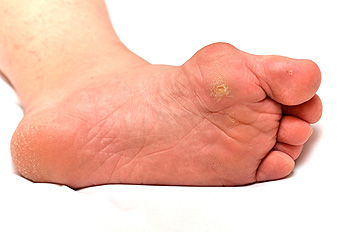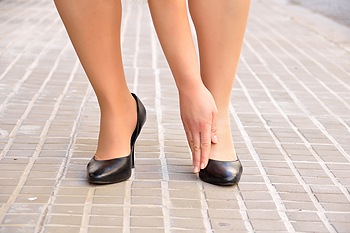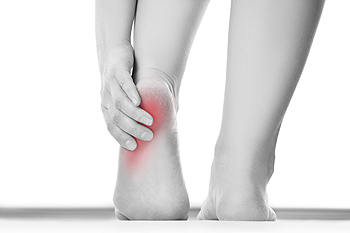March 2019
Where are Corns Located?
 A corn on the foot is a small, hardened portion of skin that develops as a result of excess friction which occurs to that part of the foot. They are known to develop in specific areas of the foot, which often includes the sides or bottom of the feet, between the toes, or possibly underneath the toenail bed. They can be quite painful, especially while wearing shoes, and may appear to have a rough texture. Common reasons why corns may develop can come from wearing shoes that are too tight, or from standing or walking for extended periods of time. Mild relief may be found by putting a corn pad over the affected area, and this may be effective in relieving a portion of the pressure. If you have a corn that will not heal, it is suggested to speak with a podiatrist who can offer additional treatment options.
A corn on the foot is a small, hardened portion of skin that develops as a result of excess friction which occurs to that part of the foot. They are known to develop in specific areas of the foot, which often includes the sides or bottom of the feet, between the toes, or possibly underneath the toenail bed. They can be quite painful, especially while wearing shoes, and may appear to have a rough texture. Common reasons why corns may develop can come from wearing shoes that are too tight, or from standing or walking for extended periods of time. Mild relief may be found by putting a corn pad over the affected area, and this may be effective in relieving a portion of the pressure. If you have a corn that will not heal, it is suggested to speak with a podiatrist who can offer additional treatment options.
Corns can make walking very painful and should be treated immediately. If you have questions regarding your feet and ankles, contact Dr. Robert Graser of Graser Podiatry and Bunion Surgery Institute. Our doctor will treat your foot and ankle needs.
Corns: What Are They? And How Do You Get Rid of Them?
Corns are thickened areas on the skin that can become painful. They are caused by excessive pressure and friction on the skin. Corns press into the deeper layers of the skin and are usually round in shape.
Ways to Prevent Corns
There are many ways to get rid of painful corns such as:
- Wearing properly fitting shoes that have been measured by a professional
- Wearing shoes that are not sharply pointed or have high heels
- Wearing only shoes that offer support
Treating Corns
Although most corns slowly disappear when the friction or pressure stops, this isn’t always the case. Consult with your podiatrist to determine the best treatment option for your case of corns.
If you have any questions please feel free to contact our office located in Boerne, . We offer the newest diagnostic and treatment technologies for all your foot and ankle needs.
Possible Foot Conditions May Develop from Standing
 If you work on your feet and stand for the majority of the day, it is important to take care of your feet by choosing the correct shoes. They should have adequate arch support and the heel should be two inches or lower. There are several people who stand in one position for extended periods of time, and this may diminish blood flow to the muscles. Additionally, there may be other conditions that can develop from standing while you’re working. These may include swollen feet, plantar fasciitis, or Achilles tendinitis. It may be beneficial to take breaks which allows you to sit down and rest your feet as frequently as possible. Anti-fatigue mats may be helpful in providing extra support and cushioning that the feet need, and many people find it advantageous to wear cotton socks which are more breathable than nylons. If you would like additional information about how to take care of your feet while working, please speak to a podiatrist who can properly assist you.
If you work on your feet and stand for the majority of the day, it is important to take care of your feet by choosing the correct shoes. They should have adequate arch support and the heel should be two inches or lower. There are several people who stand in one position for extended periods of time, and this may diminish blood flow to the muscles. Additionally, there may be other conditions that can develop from standing while you’re working. These may include swollen feet, plantar fasciitis, or Achilles tendinitis. It may be beneficial to take breaks which allows you to sit down and rest your feet as frequently as possible. Anti-fatigue mats may be helpful in providing extra support and cushioning that the feet need, and many people find it advantageous to wear cotton socks which are more breathable than nylons. If you would like additional information about how to take care of your feet while working, please speak to a podiatrist who can properly assist you.
While working on the feet, it is important to take the proper care of them. For more information about working on your feet, contact Dr. Robert Graser from Graser Podiatry and Bunion Surgery Institute. Our doctor will treat your foot and ankle needs.
Working on Your Feet
Standing on your feet for long periods of time can cause stress and pain in your feet. Your whole body may experience change in terms of posture, back pain, bunions, callouses and or plantar warts. There are ways to avoid these conditions with proper foot care, smart choices and correct posture.
Positive Changes
Negative heeled shoe – Choosing this shoe type places the heel slightly lower than the ball of the foot. These are great for overall foot health. Find shoes that fit you correctly.
Go barefoot – Our feet were not designed to be enclosed for all hours of the day. Try to periodically expose your feet to air.
Eliminate Pain
Foot Exercises – Performing simple exercises, incorporating yoga and doing stretches are beneficial. This will allow increased blood flow to the area and muscles of the foot.
Achilles tendon – Stretching the foot out flat on the floor will relax the calf muscles and tendon. These exercises can be performed almost anywhere. Make sure you add these exercises to your daily regimen.
With a little bit of this information and knowing more about foot health, you will notice changes. Foot stretches and proper footwear will help with pain and prevent further issues.
If you have any questions please feel free to contact our office located in Boerne, . We offer the newest diagnostic and treatment technologies for all your foot and ankle needs.
Where Are Plantar Warts Located?
 The symptoms of a plantar wart include pain and discomfort that is felt in the heel area of the foot. This is a result of the wart growing into the heel, which differs from warts on other parts of the body that grow outward. This condition is known to be contagious and prevention may be obtained by using your own towels and other personal items. If you have a plantar wart, it may dissolve on its own. If it causes severe pain and you are having difficulty in walking, it is suggested to speak to a podiatrist who can perform freezing techniques or possibly recommend surgery, which may be helpful in removing the wart.
The symptoms of a plantar wart include pain and discomfort that is felt in the heel area of the foot. This is a result of the wart growing into the heel, which differs from warts on other parts of the body that grow outward. This condition is known to be contagious and prevention may be obtained by using your own towels and other personal items. If you have a plantar wart, it may dissolve on its own. If it causes severe pain and you are having difficulty in walking, it is suggested to speak to a podiatrist who can perform freezing techniques or possibly recommend surgery, which may be helpful in removing the wart.
Plantar warts can be very uncomfortable. If you need your feet checked, contact Dr. Robert Graser from Graser Podiatry and Bunion Surgery Institute. Our doctor will assist you with all of your foot and ankle needs.
About Plantar Warts
Plantar warts are the result of HPV, or human papillomavirus, getting into open wounds on the feet. They are mostly found on the heels or balls of the feet.
While plantar warts are generally harmless, those experiencing excessive pain or those suffering from diabetes or a compromised immune system require immediate medical care. Plantar warts are easily diagnosed, usually through scraping off a bit of rough skin or by getting a biopsy.
Symptoms
- Lesions on the bottom of your feet, usually rough and grainy
- Hard or thick callused spots
- Wart seeds, which are small clotted blood vessels that look like little black spots
- Pain, discomfort, or tenderness of your feet when walking or standing
Treatment
- Freezing
- Electric tool removal
- Laser Treatment
- Topical Creams (prescription only)
- Over-the-counter medications
To help prevent developing plantar warts, avoid walking barefoot over abrasive surfaces that can cause cuts or wounds for HPV to get into. Avoiding direct contact with other warts, as well as not picking or rubbing existing warts, can help prevent the further spread of plantar warts. However, if you think you have developed plantar warts, speak to your podiatrist. He or she can diagnose the warts on your feet and recommend the appropriate treatment options.
If you have any questions please feel free to contact our office located in Boerne, . We offer the newest diagnostic and treatment technologies for all your foot and ankle needs.
The Benefits of Having Foot Surgery Performed
 There are several reasons why having foot surgery performed may benefit the overall health of the feet. These may include restoring mobility in the foot or ankle, relieving pain that may be present, or possibly correcting a foot deformity. Removing an ingrown toenail may be an option if the nail is severely infected. If you have a bunion that is causing extreme pain and discomfort, bunion surgery may be an option to think about if other treatments have not been successful. Patients who have sustained an injury to the joints of the ankle may consider having ankle replacement surgery performed. This may be used as a last resort to regain mobility and strength in the ankle and surrounding areas. If you have foot conditions, which may benefit by having surgery performed, it is advised to consult with a podiatrist who can properly assist you.
There are several reasons why having foot surgery performed may benefit the overall health of the feet. These may include restoring mobility in the foot or ankle, relieving pain that may be present, or possibly correcting a foot deformity. Removing an ingrown toenail may be an option if the nail is severely infected. If you have a bunion that is causing extreme pain and discomfort, bunion surgery may be an option to think about if other treatments have not been successful. Patients who have sustained an injury to the joints of the ankle may consider having ankle replacement surgery performed. This may be used as a last resort to regain mobility and strength in the ankle and surrounding areas. If you have foot conditions, which may benefit by having surgery performed, it is advised to consult with a podiatrist who can properly assist you.
Foot surgery is sometimes necessary to treat a foot ailment. To learn more, contact Dr. Robert Graser of Graser Podiatry and Bunion Surgery Institute. Our doctor will assist you with all of your foot and ankle needs.
When Is Surgery Necessary?
Foot and ankle surgery is generally reserved for cases in which less invasive, conservative procedures have failed to alleviate the problem. Some of the cases in which surgery may be necessary include:
- Removing foot deformities like bunions and bone spurs
- Severe arthritis that has caused bone issues
- Cosmetic reconstruction
What Types of Surgery Are There?
The type of surgery you receive will depend on the nature of the problem you have. Some of the possible surgeries include:
- Bunionectomy for painful bunions
- Surgical fusion for realignment of bones
- Neuropathy decompression surgery to treat nerve damage
Benefits of Surgery
Although surgery is usually a last resort, it can provide more complete pain relief compared to non-surgical methods and may allow you to finally resume full activity.
Surgical techniques have also become increasingly sophisticated. Techniques like endoscopic surgery allow for smaller incisions and faster recovery times.
If you have any questions please feel free to contact our office located in Boerne, . We offer the newest diagnostic and treatment technologies for all your foot and ankle needs.
Blog Archives
- July 2024
- June 2024
- May 2024
- April 2024
- March 2024
- February 2024
- January 2024
- December 2023
- November 2023
- October 2023
- September 2023
- August 2023
- July 2023
- June 2023
- May 2023
- April 2023
- March 2023
- February 2023
- January 2023
- December 2022
- November 2022
- October 2022
- September 2022
- August 2022
- July 2022
- June 2022
- May 2022
- April 2022
- March 2022
- February 2022
- January 2022
- December 2021
- November 2021
- October 2021
- September 2021
- August 2021
- July 2021
- June 2021
- May 2021
- April 2021
- March 2021
- February 2021
- January 2021
- December 2020
- November 2020
- October 2020
- September 2020
- August 2020
- July 2020
- June 2020
- May 2020
- April 2020
- March 2020
- February 2020
- January 2020
- December 2019
- November 2019
- October 2019
- September 2019
- August 2019
- July 2019
- June 2019
- May 2019
- April 2019
- March 2019
- February 2019
- January 2019
- December 2018
- November 2018
- October 2018
- September 2018
- August 2018
- July 2018
- June 2018
- May 2018








